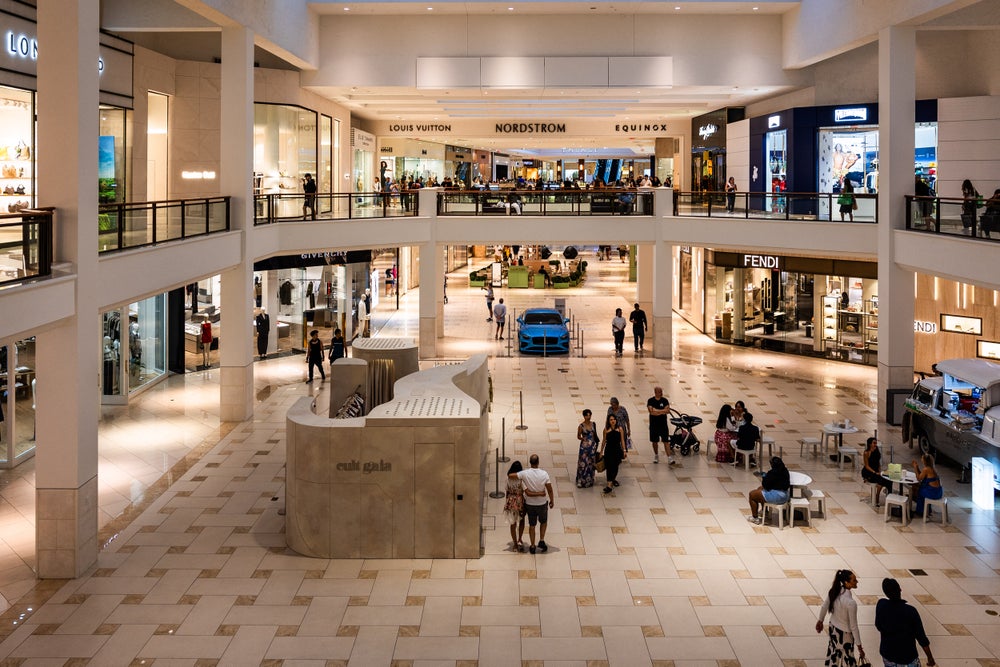Key Takeaways
- Rose is the CEO and founder of United National Consumers Suppliers (UNCS), which supplies 165,000 retailers and counting.
- He predicted the fall of the mall and other significant industry shifts. Here’s what he thinks will happen next — and how to prepare.
This as-told-to story is based on a conversation with Brett Rose, the CEO and founder of multimillion-dollar wholesale business United National Consumer Suppliers (UNCS), which supplies 165,000 retailers and counting, including Macy’s, TJX, Sam’s Club, Dollar Tree, Amazon resellers and more. Rose moves hundreds of millions of dollars in goods each quarter. He’s also predicted major trends in the retail sector, such as the fall of the mall, rise of off-brands and omnichannel influence. The piece has been edited for length and clarity.
Image Credit: Courtesy of UNCS. Brett Rose.
About 23 years ago, I had a really good friend of mine whose dad worked for a retailer that is now out of business called Building 19, and he had four trucks of women’s purses sitting in his warehouse. And I use the term women’s purses lightly — they were worth dollars; it wasn’t Chanel. So I picked up the Yellow Pages and found someone who wanted to buy them.
That first sale was a great lesson in business because it was four trucks of merchandise, and I had to borrow money from my parents for it; three trucks were delivered, but the driver of the fourth truck, which in theory held all of our revenue, rolled that truck. Fortunately, no one was hurt, but all of a sudden, during my first week in business, I had to learn how to file an insurance claim — the things they don’t teach you in school.
But, against my parents’ better judgment, I set out to try it one more time. I bought a truck of rubber bands, then a truck of sewing needles and thread. I bought what was in front of me; the world was a little bit smaller back then. Email was in its early stages, and the internet isn’t what it is now. I didn’t know what I didn’t know, and as a 25-year-old with no money and no network, I needed to figure it out — and they say necessity is the root of all invention.
Related: I Scaled My Regional Business Into a National One With Smart Acquisitions — Here’s How
Our first major retailer was the second deal we ever did. There was a company based out of Massachusetts, which unfortunately is no longer in business, called Christmas Tree Shops. They were pretty big and ultimately became a division of Bed Bath & Beyond. I literally went on AOL, typed in Christmas Tree Shop’s corporate office, picked up the phone and introduced myself and my company. I probably gave off that I was bigger than I was. I’ll never forget that the gentleman’s name was Terry O’Neill, and he agreed to give me a shot.
Our third deal was sold to Dollar General, which at the time was one of the biggest retailers in the world. That taught me another interesting lesson because the buyer asked if I had $5 million worth of liability insurance. I said absolutely, then hung up the phone, called my buddy and asked what liability insurance was and how to get it right. I was sort of faking it until I made it.
Soon after that, we hit the ground running. After every deal we did, we added another retailer. I’d go on MySpace and ask my friends who lived in the Northeast which retailers they liked, then make it my goal of the day and just figure out how to make it happen.
At this point, we sell to 165,000 in 34 countries. Some of those include Amazon, Macy’s, TJ Maxx, Marshalls, Dollar Tree and Sam’s Club. Our number of retailers grows daily, but we’re not heavy on any one customer. I have friends who have built great businesses selling to just Walmart or Costco, but I always wanted to be careful, and because of that, we diversified. We’re constantly adding new retailers and, more importantly, new suppliers. Now we sell to a lot of convenience stores. We sell to a lot of department stores. We do a huge hardware and farm and feed store. As a kid from Boston and Florida, I never knew what a farm and feed store was in my life. I don’t think I ever walked into one before 15 years ago, and now it’s a huge division of ours.
Nowadays, we’re introducing more and more technology into the company, and it’s been one of the biggest inflection points in our history. All of a sudden, we’re a tech company that happens to do merchandise distribution; we’re no longer a general merchandise distribution company that happens to use tech. Every day is a new educational opportunity — and it’s also the difference between 10x growth in 12 months and 10x growth over 10 years. Because of the data we’ve collected over nearly 20 years, we’re just starting to scratch the surface of what’s possible. We’re seeing double-digit growth daily and adding more people and tech daily to keep up with it.
Our biggest strategy has always been agility. The president of our company, Jeremiah Gutierrez, has been preaching that for over a decade. Tariffs change every day. It’s slightly normalizing, but even now, the market cost is so high because of that. Our ability to be flexible separates us from the competition. For example, if there’s a huge tariff on bicycles this week, we’ll switch our focus to home furnishing. We have tremendous flexibility, which allows us to give our customers normalized pricing without huge increases to offset the tariffs, which in turn translates to a better strategy for them and a better strategy for the American consumer.
One of the biggest shifts in retail that we’re starting to see right now is the return of the mall. I have a 12-year-old and a 14-year-old, and although they still purchase certain things online, they love going to the mall and buying in person. When I took them to the mall last week, it was like a meetup — they must have seen 30 of their friends, which I loved because it reminded me of the 1980s and 1990s. So I think we’re going to see a real return to traditional retail, but it has to look different.
Related: How This Small Local Bakery Turned Itself Into a Wholesale Powerhouse
There’s a mall in South Florida called the Aventura Mall that has absolutely nailed it: You walk in, and it has an amazing feel. Every storefront is different. It’s merchandised right. It’s lit right. It smells right. It caters to everybody. And when I was there, it was slammed even though it was a Friday afternoon with beautiful weather — people were there because they wanted to be. The parking lot was full. And it was an experiential shopping experience. I got my car washed while I was there. I also went to buy coffee for my espresso machine, and they handed me a shot of espresso when I walked in. It also had an arcade, which was packed. That mall should be a case study on what retail is going to become.

Image Credit: JC MILHET | Getty Images. Aventura Mall.
Also, as a parent, a constant battle of mine is how to get my kids off their phones. I watched them and their friends while we were at the mall, and sure, they were posting pictures on Snapchat, but they were also laughing, talking and shopping. There’s no denying the dopamine high when you buy something, and as a guy in my 40s, what I want is different from what my kids want — but they have something for everyone. For instance, in this mall, there’s an art gallery selling $20,000 paintings; you could go in there, and meanwhile, my daughter’s buying a $19 hoodie at Hollister. That gallery was packed, and so was Hollister. It said to me that the mall is alive and well, but not the mall that we knew in the 1980s.
There’s always going to be consumerism. If I had a crystal ball for the stock market, I’d suggest looking at retailers that are category agnostic. Don’t look at a single category because that doesn’t work. Look at Walmart, Costco, Sam’s Club, Dollar Tree: These are stocks that constantly outperform the index because there’s nothing you can’t buy. Being category agnostic allows them to be agile and flexible, and I think you’ll continue to see those stores outperform others while traditional department stores continue to struggle.
Related: 3 Reasons Why the Digitization of B2B Wholesale Is Changing the Future of Retail
A professor once gave me the best advice. I said, “I’m really trying to figure out what I want to do for the rest of my life.” And he said, “Why don’t you just figure out what you want to do next?” Whether it’s the wholesale business or any business, just start. Tech has given people a shorter runway. When I started, it wasn’t that it was more challenging; it was that the challenges were different. But to find the product, the customers and the partners is shorter now because of the tech that’s at our fingertips. Now, anybody who wants to get into any business, not just a wholesale business, can be international right away.
I would also tell young entrepreneurs to remember that they’re not an island. Use the people and network around you, even if they’re not necessarily in your industry. Let them know what you’re doing because you never know who can connect you. There’s a huge value in being a human LinkedIn. I live with the mentality that we have two hands, one to help ourselves and one to help others, and if helping somebody doesn’t lead to more business for myself, that’s okay. That doesn’t matter to me. Go build a successful business and life because it comes full circle.
Key Takeaways
- Rose is the CEO and founder of United National Consumers Suppliers (UNCS), which supplies 165,000 retailers and counting.
- He predicted the fall of the mall and other significant industry shifts. Here’s what he thinks will happen next — and how to prepare.
This as-told-to story is based on a conversation with Brett Rose, the CEO and founder of multimillion-dollar wholesale business United National Consumer Suppliers (UNCS), which supplies 165,000 retailers and counting, including Macy’s, TJX, Sam’s Club, Dollar Tree, Amazon resellers and more. Rose moves hundreds of millions of dollars in goods each quarter. He’s also predicted major trends in the retail sector, such as the fall of the mall, rise of off-brands and omnichannel influence. The piece has been edited for length and clarity.

Image Credit: Courtesy of UNCS. Brett Rose.
About 23 years ago, I had a really good friend of mine whose dad worked for a retailer that is now out of business called Building 19, and he had four trucks of women’s purses sitting in his warehouse. And I use the term women’s purses lightly — they were worth dollars; it wasn’t Chanel. So I picked up the Yellow Pages and found someone who wanted to buy them.
The rest of this article is locked.
Join Entrepreneur+ today for access.
